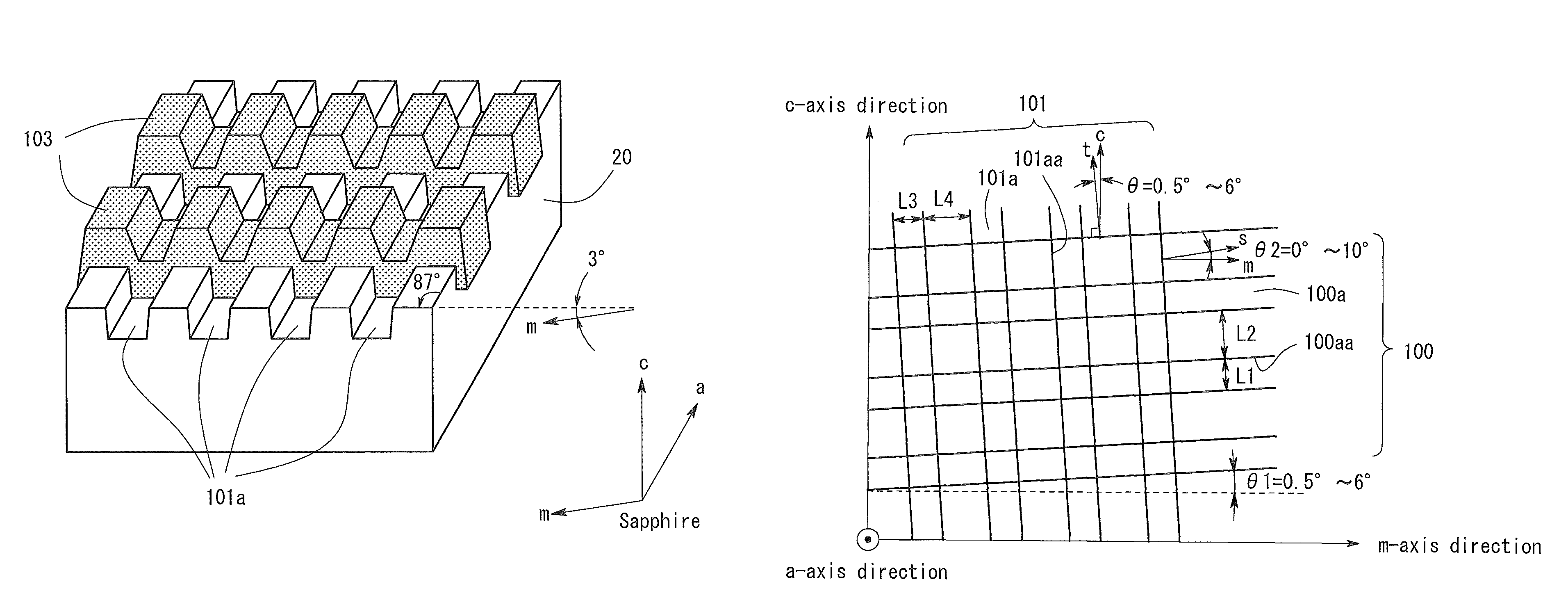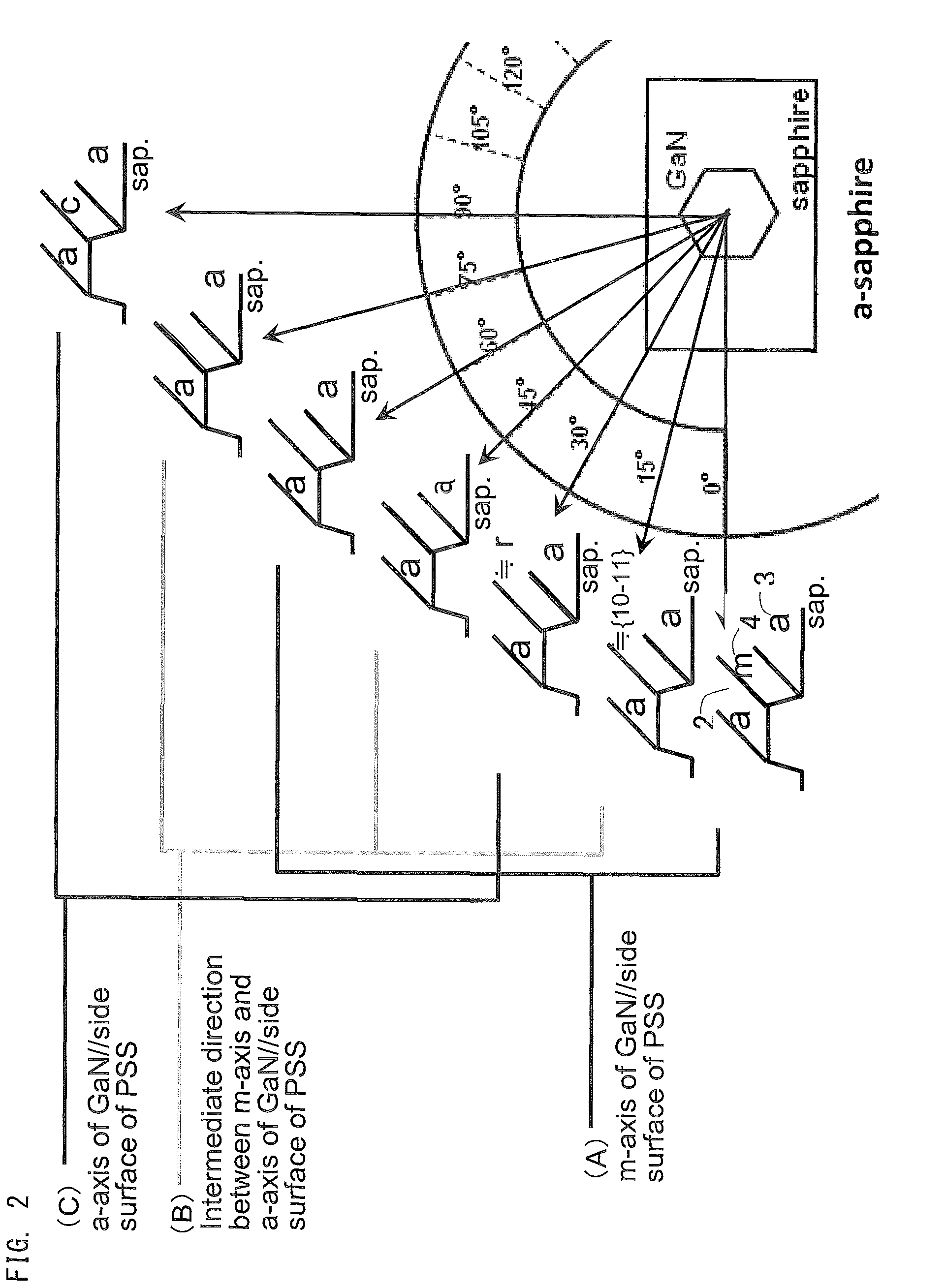Method for producing Group III nitride semiconductor and Group III nitride semiconductor
a technology of nitride semiconductor and semiconductor, which is applied in the direction of semiconductor devices, basic electric elements, electrical apparatus, etc., can solve the problems of slow lateral growth of gan grown on the side surfaces of trenches or posts, deterioration of crystallinity and flatness of group iii nitride semiconductor, and low external quantum efficiency, so as to improve external quantum efficiency and reduce the effect of dislocation density
- Summary
- Abstract
- Description
- Claims
- Application Information
AI Technical Summary
Benefits of technology
Problems solved by technology
Method used
Image
Examples
embodiment 1
[0068]Firstly, a relationship between the crystal orientation of the stripe structure and the crystal quality of grown GaN will be described.
[0069]GaN crystals were grown on a sapphire substrate having a thickness of 500 μm and a c-plane main surface on which processed side surfaces are formed in different crystal orientations. As shown in FIG. 1, posts 2 and trenches 3 were radially formed in a stripe pattern on the main surface of the sapphire substrate. The posts 2 and the trenches 3 were formed by forming the trenches 3 through dry etching. An interval angle of adjacent posts 2 is 0.01°. Each of the trenches 3 has a depth of 0.7 μm. Each of the trenches 3 has a width of 2.0 μm, and each of the posts 2 has a width of 2.0 μm. After the processed substrate was placed in a MOCVD growth apparatus and cleaned with a hydrogen gas, an AlN low-temperature buffer layer was formed. Thereafter, GaN was grown under the conditions for vertical growth.
[0070]In FIG. 1, when a stripe of post 2 i...
embodiment 2
[0102]Next will be described the case where GaN crystals were grown on a sapphire substrate having an a-plane main surface. In the present embodiment as well, the processed side surface is considered as perpendicular to the main surface of the substrate for ease of explanation. As shown in FIG. 2, posts 2 and trenches 3 were radially formed at an interval angle of 0.01° on the main surface of sapphire. In FIG. 2, when the stripe direction of the post 2 is in a direction of 0° to the baseline of the sapphire substrate, the side surface 4 of the post 2 is the m-plane of sapphire (the lateral vector is the m-axis). When the stripe direction of the post 2 is in a direction of 90° to the baseline of the sapphire substrate, the side surface 4 of the post 2 is the c-plane of sapphire (the lateral vector is the c-axis). When the stripe direction is in an intermediate direction of 30° between 0° and 90°, the side surface 4 of the post 2 is a plane close to the r-plane (−1012) of sapphire (th...
embodiment 3
[0111]This embodiment is an example using a Group III nitride semiconductor substrate instead of a sapphire substrate in Embodiments 1 and 2. In this case, as shown in FIG. 21, the main surface of the substrate is a c-plane. A concave-convex structure was formed so that the first angle θ1 between the first lateral vector t of the first processed side surface 100aa of the first stripe structure 100 on the substrate and the m-axis projected vector m obtained by orthogonally projecting the normal vector of the m-plane to the main surface of the substrate is from 0.5° to 6°, and the second angle θ2 between the second lateral vector s of the second processed side surface 101aa of the second stripe structure 101 and the a-axis projected vector a obtained by orthogonally projecting the normal vector of the a-plane to the main surface of the substrate is from 0° to 10°.
[0112]In this case, the Group III nitride semiconductor substrate is grown in the c-axis direction on the top surfaces of t...
PUM
 Login to View More
Login to View More Abstract
Description
Claims
Application Information
 Login to View More
Login to View More - R&D
- Intellectual Property
- Life Sciences
- Materials
- Tech Scout
- Unparalleled Data Quality
- Higher Quality Content
- 60% Fewer Hallucinations
Browse by: Latest US Patents, China's latest patents, Technical Efficacy Thesaurus, Application Domain, Technology Topic, Popular Technical Reports.
© 2025 PatSnap. All rights reserved.Legal|Privacy policy|Modern Slavery Act Transparency Statement|Sitemap|About US| Contact US: help@patsnap.com



